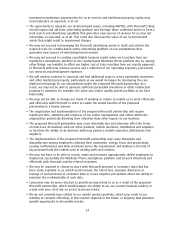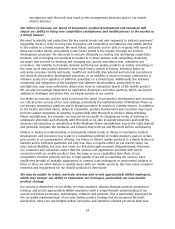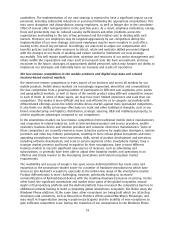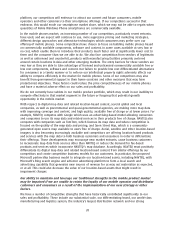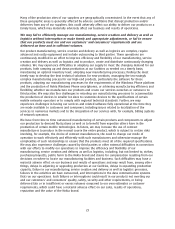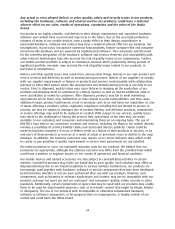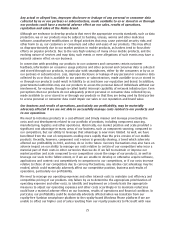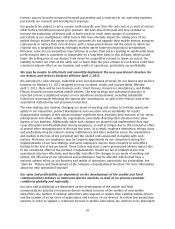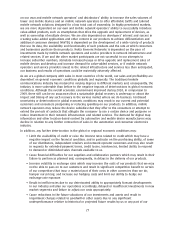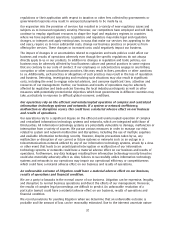Nokia 2010 Annual Report Download - page 23
Download and view the complete annual report
Please find page 23 of the 2010 Nokia annual report below. You can navigate through the pages in the report by either clicking on the pages listed below, or by using the keyword search tool below to find specific information within the annual report.may result in more variable quality due to our more limited control which may have a
negative effect on our reputation and erode the value of the Nokia brand.
The failure of the limited number of suppliers we depend on for the timely delivery of
sufficient quantities of fully functional components, subassemblies and software on favorable
terms and for their compliance with our supplier requirements could materially adversely
affect our ability to deliver our mobile products profitably and on time.
Our manufacturing operations depend on obtaining sufficient quantities of fully functional
components, subassemblies and software on a timely basis. Our principal supply requirements for
our mobile products are for electronic components, mechanical components and software, which all
have a wide range of applications in our products.
In some cases, a particular component may be available only from a limited number of suppliers. In
addition, our dependence on thirdparty suppliers has increased as a result of our strategic decisions
to outsource certain activities, for example parts of our own chipset as well as wireless modems R&D,
and to expand the use of commercially available chipsets and wireless modems. Suppliers may from
time to time extend lead times, limit supplies, change their partner preferences, increase prices or be
unable to increase supplies to meet increased demand due to capacity constraints or other factors,
which could adversely affect our ability to deliver our mobile products on a timely basis. If we fail to
anticipate customer demand properly, an oversupply or undersupply of components and production
capacity could occur. In many cases, some of our competitors utilize the same contract manufacturers.
If they have purchased capacity ahead of us, this could prevent us from acquiring the needed
products, which could limit our ability to supply our customers or increase our costs. We also commit
to certain capacity levels or component quantities which, if unused, will result in charges for unused
capacity or scrapping costs. Additionally, with the increased bargaining power of other large
manufacturers in the mobile device and electronics industry, we may not be able to achieve as
favorable terms as in the past resulting in increased costs that we may not be able to pass on to our
customers, as well as lapses in the availability of certain components, especially in situations of tight
supply.
Moreover, a supplier may fail to meet our supplier requirements, such as, most notably, our and our
customers’ and consumers’ product quality, safety, security and other standards. Consequently, some
of our products may be unacceptable to us and our customers and consumers, or may fail to meet
our quality controls. In case of issues affecting a product’s safety or regulatory compliance, we may
be subject to damages due to product liability, or defective products, components or services may
need to be replaced or recalled. Also, some suppliers may not be compliant with local laws, including,
among others, local labor laws. In addition, a component supplier may experience delays or
disruption to its manufacturing processes or financial difficulties or even insolvency or closure of its
business, in particular due to difficult economic conditions. Due to our high volumes, any of these
events could delay our successful and timely delivery of products that meet our and our customers’
and consumers’ quality, safety, security and other requirements, or otherwise materially adversely
affect our sales and results of operations or our reputation and brand value.
Possible consolidation among our suppliers could potentially result in larger suppliers with stronger
bargaining power and limit the choice of alternative suppliers, which could lead to an increase in the
cost, or limit the availability, of components that may materially adversely affect our sales and results
of operations. The intensive competition among our suppliers and the resulting pressure on their
profitability, as well as negative effects from shifts in demand for components and subassemblies,
may result in the exit of certain suppliers from our industry and decrease the ability of some
suppliers to invest in the innovation that is vital for our business. Further, our dependence on a
limited number of suppliers that require purchases in their home country foreign currency increases
our exposure to fluctuations in the exchange rate between the euro, our reporting currency, and such
foreign currency and, consequently, may increase our costs which we may not be able to pass on to
our customers.
22




